An Honest Review of ADT Home Security
I tested ADT in my house and researched all of their plans - you might be surprised by what I found.
SafeHome.org may receive compensation from some providers listed on this page. Learn More
We may receive compensation from some providers listed on this page. Learn More
I tested ADT in my house and researched all of their plans - you might be surprised by what I found.
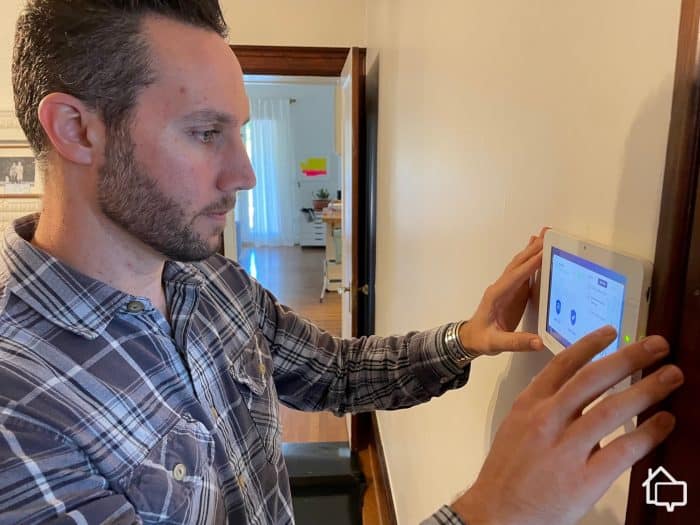
Testing the ADT Control Panel
Latest News: ADT has launched a new security system that is different from the one I tested. The company is naming it ADT Plus, and professional installation is now optional. It also comes with a new feature called Trusted Neighbor that allows you to assign people you trust access to your smart lock and security system at certain times or during certain events, like when a package is left at your door. I briefly discuss it in an update below, after I talk about the equipment I tested.
Who hasn’t heard of ADT, right? Those blue signs are in yards all over the place. ADT’s name recognition isn’t all about product placement, though. This is the oldest home security company in the industry, with over 150 years of experience. With that longevity, you can build up a serious reputation. OK, fine. A name is a name. A reputation is a reputation. How do ADT systems actually work? There’s one way to answer that question – hands-on testing.
You don’t have time for that. Going online, comparing options, selecting the right package, scheduling installation, testing all the individual components, calling customer support just to make sure they’re awake at 3 am. All that to test out a home security system. At least, that’s what I do. So, I purchased an ADT security system for my home and then put it through its paces. Now, I’m here to tell the tale.
The bottom line, in case you’re one of those people who likes to jump to the end…ADT’s reputation is well-earned. In fact, I’ll confess something…ADT gives customers a full six months to test and return their systems. That’s by far the longest money-back guarantee in the business. I liked mine so much, though, that I kept it. For good.
ADT systems are not perfect. No systems are. And it may not be right for you. Only when you consider all the options will you know that. So let’s consider all the options starting with ADT. We’ll make some other suggestions throughout too.
Rob Gabriele has tested hundreds of home security products and has spent thousands of hours researching home security technology. He’s been cited for his home security expertise in the Washington Post, New York Times, and other major media outlets. And he’s been sought out by local and national news channels for his expertise in keeping burglars and thieves at bay.
FYI: ADT is our #1 pick security system overall. It’s also #4 on our list of the best security systems for vacation homes, and our #2 pick for security systems with security cameras.
With 150 years of experience in the home security industry, ADT is what you might call a traditional company. Traditionally, you didn’t go to Best Buy or Home Depot, load up on equipment, and head home to install it yourself. You talked one-on-one with a customer service agent who recommended a system that would fit your individual needs. You negotiated a price. You scheduled an installation appointment, and professional installers did the dirty work.
ADT still does things this way. In the past year, the company has introduced a DIY-installed system. You have to change with the times, right? Self-installed systems are pretty popular, and ADT didn’t want to miss the boat. Along the same lines, you can now access all of ADT’s pricing information on the company’s homepage, and price negotiation seems a thing of the past (read our ADT Self Setup review for more information).
Nevertheless, the company still prides itself on its white-glove service, and that includes the option for professional installation, just like in the old days. So, while we have tested ADT’s self-setup process, this time around we thought we’d stick to the professional option – consultations, professional installation, the whole nine yards.
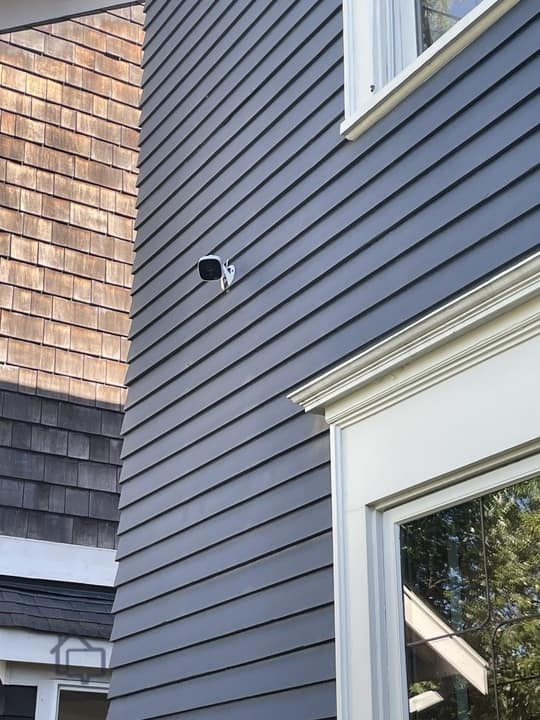
ADT Outdoor Camera in Action
Pro Tip: Wondering what’s on the other side of the home security fence? Check out my roundup of the top DIY-installed security systems. They may require more effort from you, but they’re undoubtedly more flexible than professionally installed systems.
The whole shopping/consultation/installation process typically takes between three and five days. A lot of this time is spent on the installation because you have to schedule an appointment, and depending on where you live, availability can be limited. We managed to get everything done in two days, though, which, given all the steps involved, was pretty impressive.
If all of this sounds like a lot, that’s because it is. I had to stay home from the office a couple of days, when I could have installed a DIY system myself in the evenings or on a weekend.
The thing is, home security is serious business. According to the FBI, there’s a burglary in the U.S. every 23 seconds.1 We appreciate the fact that ADT treats it seriously. Both our consultants and our installers were thorough. They identified hazards and vulnerable points. They knew exactly what kind of equipment we needed, and they knew where to place it for maximum coverage. I was on the fence about a camera for my backyard, for instance, but ADT explained why I needed it and assured me I could protect the whole area with just one camera. Easy to see why ADT tops our list of best professionally installed systems.
We get it – not everyone has two days to take off from work. When you think about it, though, a couple of days isn’t a lot to give up in exchange for the kind of safety and security you get with an ADT system.
Side Note: ADT’s new security system, ADT Plus, could eliminate the need for a consultation. It seems that ADT still offers the service, but you can now also build and buy your system online. I also noticed that professional installation is optional; you can DIY the install for free or you can pay for professional installation. I like these changes because it gives homeowners more freedom, while maintaining that “white glove” feel for those who want it.
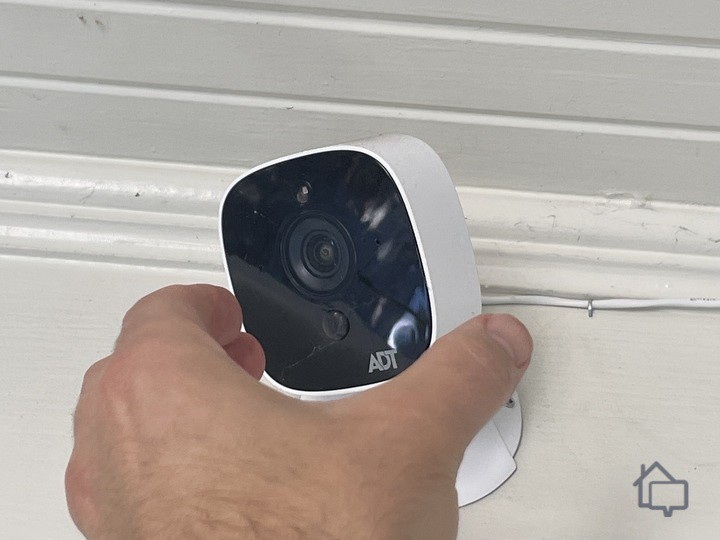
A Closer Look at ADT Outdoor Camera, Installed in Our Back Porch
Nobody’s perfect, and we won’t pretend ADT is. Their mistakes were minor, but we should mention them. First, while our installation tech did a great job of hiding most of the system’s wires, they missed one on our outdoor camera. It’s practically begging to be snipped by a burglar. Our to-do list includes a call to ADT to get someone back to our house to fix it.
The bigger problem for us is that ADT just leaves all the existing security equipment in your house, even if it’s ADT equipment. These aren’t simple systems, as we’ve tried to make clear, and we’re not really qualified to take them down. That means we’ve got this nice, sleek new system now right next to a lot of outdated, clunky equipment. ADT couldn’t maybe offer some sort of free removal service? That would seem like a perk, especially for repeat customers like us.
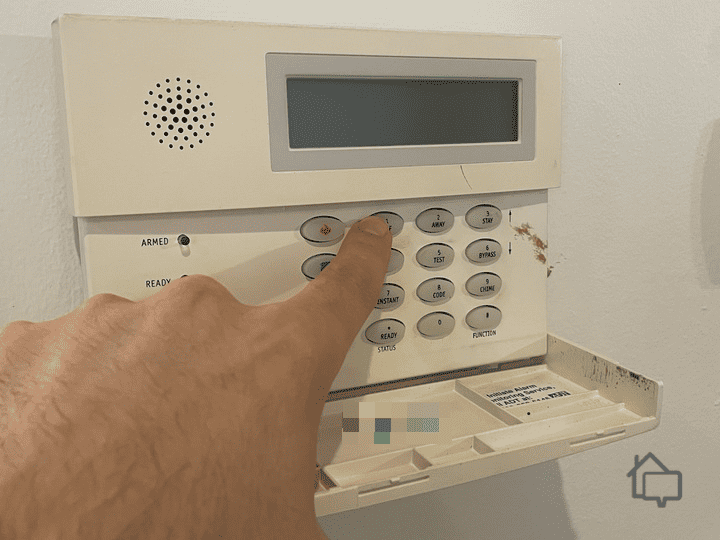
Old School ADT Equipment
FYI: Not sure if ADT’s professional installation is right for you? See how ADT compares with DIY security systems and make an informed choice. And keep in mind, you can also DIY the new ADT Plus security system. It offers most of the same equipment as the system I tested, except for the touchscreen control panel. ADT Plus comes with a touch keypad.
So much for the installation. What did we make of the equipment?
We’ve already mentioned a couple of gripes we have with ADT, and we’ll talk about a few more later. Equipment is definitely not one of them, though. If it’s an ADT device, it’s manufactured by GE, which means you don’t have to worry about durability, reliability, or aesthetics. We were even able to get brown sensors to better match our interior decor.
ADT also offers Google Nest equipment, though, including the Nest Hub, all models of Nest Cams, Nest Doorbells, and Nest thermostats. This equipment isn’t just reliable but packed with some of the most advanced tech in the industry. The Nest doorbell, for example, is one of the few doorbells on the market that offers facial recognition. When our normal mailman was on vacation, we knew it.
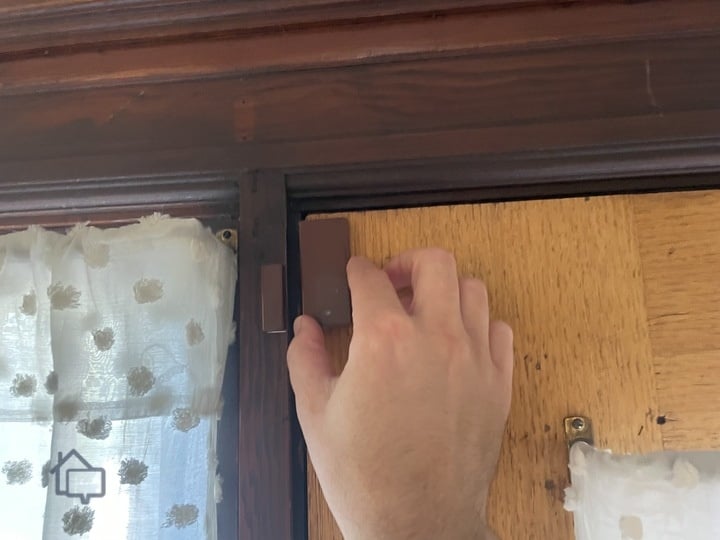
ADT matched the entryway sensor to our trim color!
As much as we love SimpliSafe (it’s #2 on our list of best systems), the company’s equipment just feels cheaper than ADT’s. If you plan to keep your home security system for several years – and let’s face it, the world isn’t getting any safer – it’s helpful to have gear that’s built to last.
Our ADT package included:
There are plenty more devices available from ADT, though, including:
All-in-all, equipment is one of ADT’s strongest points, and this is a company with a number of strong points.
I paid $1,200 for my ADT system, installation included. Sounds expensive, right? It’s true that, compared to Ring, SimpliSafe, and abode – three of our top DIY security systems – ADT is pretty pricey. But thankfully I was able to finance all of the equipment over three years and pay a very reasonable $30 per month (for equipment only).
That’s how it works with ADT. Instead of paying $500-$1,000+ upfront, you make monthly payments on your system over 24 to 60 months. It’s easier on the wallet but allows you to get top-of-the-line equipment. What I don’t love about this arrangement is that when my contract is up, I won’t own the home security equipment. I can still use it, but if I ever cancel, ADT gets it all back. (In hindsight, I should have canceled my old account. ADT’s technician might have taken my old equipment if I did.)
Pro Tip: The professional installation service cost me a little over $100 – par for the course for non-DIY systems – but it doesn’t hurt to ask it to be waived during the consultation phase. You could also try your luck with ADT deals. They sometimes offer $0 installation or discounted installation for cameras and video doorbells.
You’ll also have to pay between $29.99 and $44.99 per month for monthly monitoring on top of equipment charges. There’s no option for monitoring the system yourself. All in all, I’m paying a little over $70 per month for everything (equipment and professional monitoring). The going rate for complete home security in the market is $50 to $70 a month. So I wouldn’t call ADT expensive. It’s still within the normal price range. It is just on the higher side of the fence, though.
| ADT pricing | Build Your Own | Starter | Premium |
|---|---|---|---|
| Total package price (equipment only) | $374.25 | $583.50 | $1,189.50 |
| Equipment fee (3-year financing) | $10.40/month | $16.21/month | $33.04/month |
| Professional monitoring fee (w/ 3-year contract) | $29.99 or $44.99/month | $44.99/month | $44.99/month |
I don’t recommend ADT for folks who have the Dave Ramsey pay-cash-for-everything mentality. I also don’t think ADT makes sense for apartment dwellers or people who are renting their homes. If either of those describes you, check out my roundup of the best security systems for apartments.
But I do recommend ADT for more established homeowners who plan to stay put in their home for at least 3-5 years.
For basic security with just security sensors, monitoring costs $29.99. That gets you professional monitoring and app access, but not much else. If you’ve outfitted your home with smart devices like locks and light bulbs, you can pay an additional $5 per month and enjoy access to ADT’s home automation features. Or you can pull out all the stops, and invest $44.99 per month for access to smart home features, professional monitoring, and security camera footage.
Here’s how ADT prices compare to the competition…
| ADT | Vivint | SimpliSafe | Ring | abode | |
|---|---|---|---|---|---|
| Installation | Professional (w/ fee) | Professional (w/ fee) | Free DIY | Free DIY | Free DIY |
| Equipment purchase | Financing | Financing | Upfront | Upfront | Upfront |
| Equipment package price | $375+ | $799+ | $250+ | $200+ | $299+ |
| Professional monitoring fee | $29.99 – $44.99 | $29.99 – $49.99 | $19.99 – $29.99 | $20 | $29.99 |
FYI: ADT professional monitoring is the gold standard. They have twelve monitoring centers spread across the nation that provide redundancy and continuous monitoring service. Even if a couple of centers fail to operate, the others can take over.
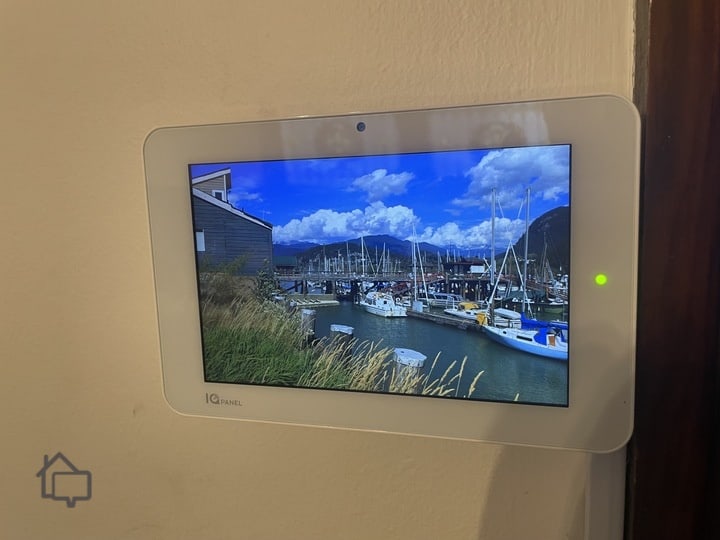
The ADT panel can display family photos, which is a nice touch
Update: ADT Plus, the new security system from ADT, has switched back to a screenless touch keypad with a separate hub or base station. It’s similar to the Frontpoint Hub our team tested, but ADT’s hub also comes with a built-in keypad. ADT Plus retained many of the core features of the touchscreen panel like cellular and battery backup. Both the wireless keypad and the hub also have a siren.
What to Expect: The new ADT control panel is touchscreen, so I love that ADT finally got with the times here. It’s compact and there’s beauty in its simplicity. I just wish the screen was a tad bigger; it’s only 7”, compared to Vivint’s Smart Hub at 8”. I don’t mind displaying a beautiful piece of technology like that one.
The ADT control panel also seems well-built. It doesn’t feel cheap and plastic-y and there’s a good heft to it. It also features cellular communication as backup to Wi-Fi. Cellular backup is key, as it keeps your system functioning even if your power or Wi-Fi goes out. The best security systems offer cellular monitoring, and I wouldn’t recommend purchasing a system without this feature. The last thing you want is to have a storm come through, disrupt your Wi-Fi connection, and have to sleep with one eye open because your home is unprotected. Trust me, it has happened to me!
Best and Worst Features of the Control Panel: The ADT control panel functions as you’d expect it to. It controls the whole ADT system via arming modes. I just didn’t like that you can’t “silent arm” the system from the control panel. So everytime I set the alarm, it counts down loudly. It’s helpful in letting you know how much time you have left to exit your home, but it’s annoying if you have little ones that need their sleep (or else). Fortunately, you can ‘silent arm’ the system via the app.
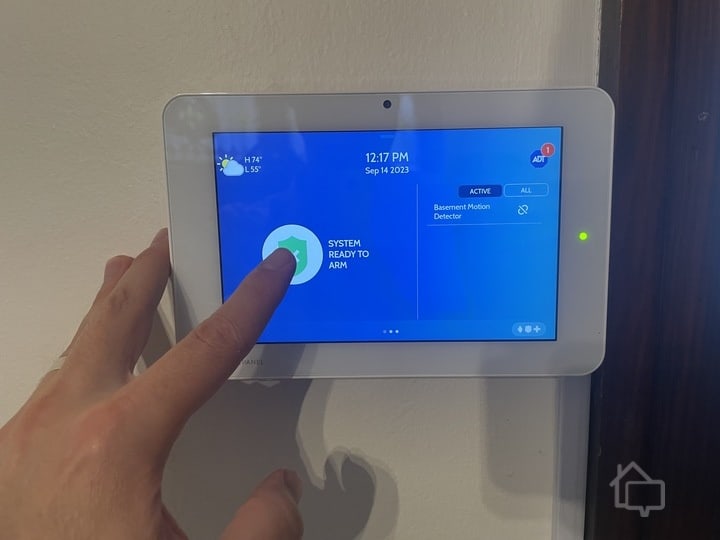
Arming my ADT System
A word on the siren. 85 dB isn’t bad, and it’ll probably startle home invaders. The industry standard these days is 100 dB, though, and if you think 85 dB will startle a potential thief, imagine what those extra 15 dB can accomplish. Let’s put it this way: I could hear ADT’s siren when I was upstairs. I had to really listen to hear it from the shower, though, and while I was in the bedroom watching TV. Turns out, thieves don’t just break in when you’re sitting quietly in your easy chair reading a book. Plus, you kind of want those extra 15 dBs to shake potential home invaders up. An alarm should be a deterrent rather than simply an annoyance. Oh, and the siren is a sustained wail rather than an oscillating wail – in technical terms, reeeeeeeeeeeee instead of reee-reee-reee-reee-reee. That’s more in the category of unique though, than disappointing.
Unexpected Findings: There were a few things that definitely surprised me, first among which was how tidily the installation technician hid the control panel wire. I wasn’t used to this, since most control panels I test have a curly-cue wire hanging down from them that just looks awful. Just look at how neat it looks on the wall.
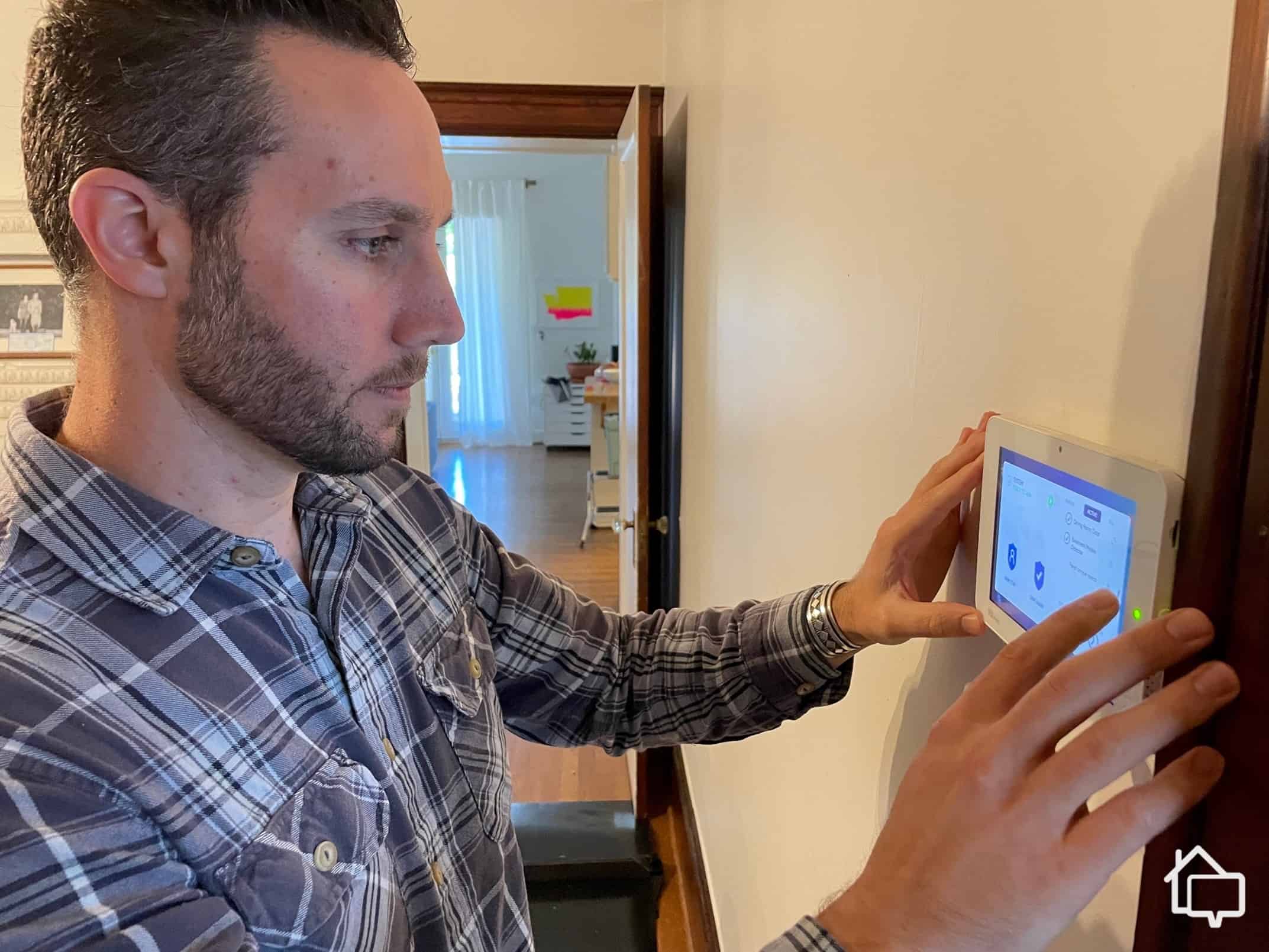
Rob Testing the ADT Control Panel
That said, the control panel looks a bit smaller in person than it does in the pictures. Maybe it’s just me, but I definitely had a larger screen in mind. On the bright side, though, there’s a front-facing camera on the control panel. You can’t take selfies with it, but it will take a snapshot of whoever tries to disarm the system so you can review who came and went from the activity log, like so:
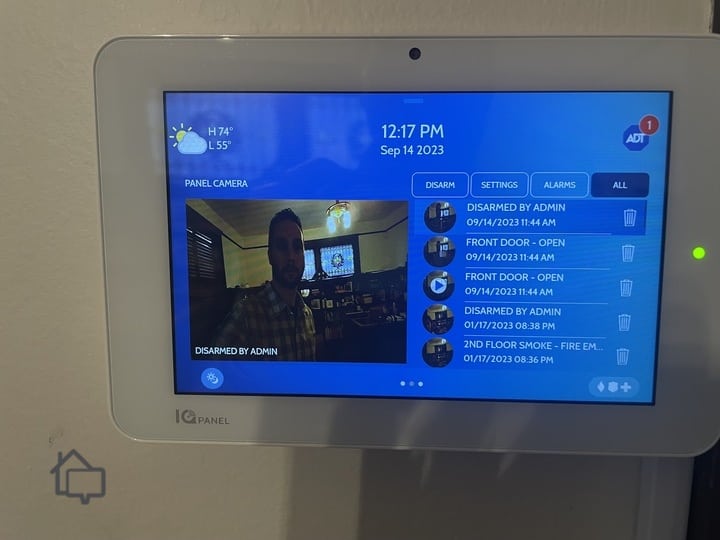
ADT Control Panel Activity Log
Lastly, the control panel doubles as a weather station and a digital picture frame when on standby. Sadly, those were the only extra features. They’re nice and all, but they’re more for aesthetic purposes than for security or convenience. Ultimately, I preferred the hub that came with the Vivint security system I tested. It let me control all of my smart devices from a single location.
All of ADT’s home automation features are exclusive to the ADT app.
Control Panel Specs:
How it Stacks Up:
I give the ADT control panel an A+. The Vivint Smart Hub is my gold standard, and compared to it, the ADT control panel falls short on some crucial features. The smaller screen size, lack of automation controls, and 85 dB siren were my biggest gripes, but it was a solid control panel all around.
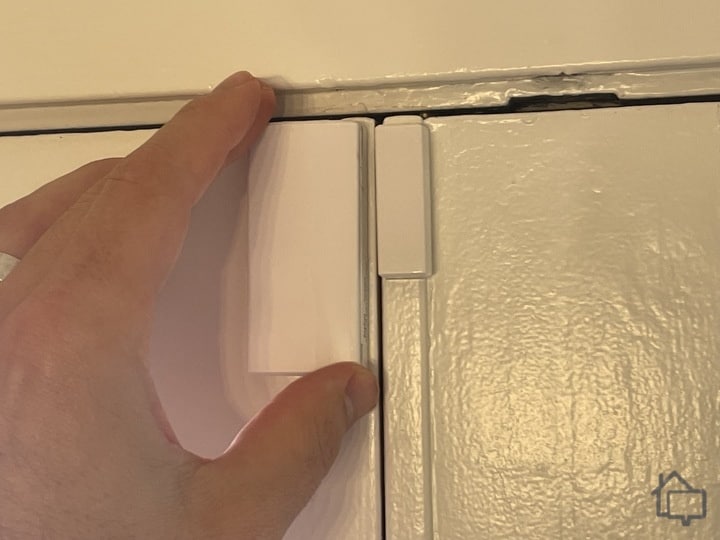
A look at ADT Entryway Sensors
What to Expect: Entryway sensors, also called door/window sensors, are the backbone of the ADT system (and every home security system for that matter). Using adhesives, the install technician mounted these sensors on every door downstairs. But I highly recommend you get these on every door and window. This time I skipped the windows to save some money, but I’m surely buying more when I schedule a visit to fix the exposed wires on my back porch camera. They cost $50 each.
As for motion sensors, I had two installed on each floor. The one on the first floor monitors the living room area. The technician made sure it has a view of my living room windows, considering I didn’t purchase entryway sensors for those. The one on the second floor is at the end of the hallway between our rooms, facing the stairs.
I also purchased three glass break sensors. I had one mounted on the wall facing the sliding glass door that leads to my back porch. And I had two mounted in the common spaces on the first floor. Can you spot the glass break sensor in the picture below?
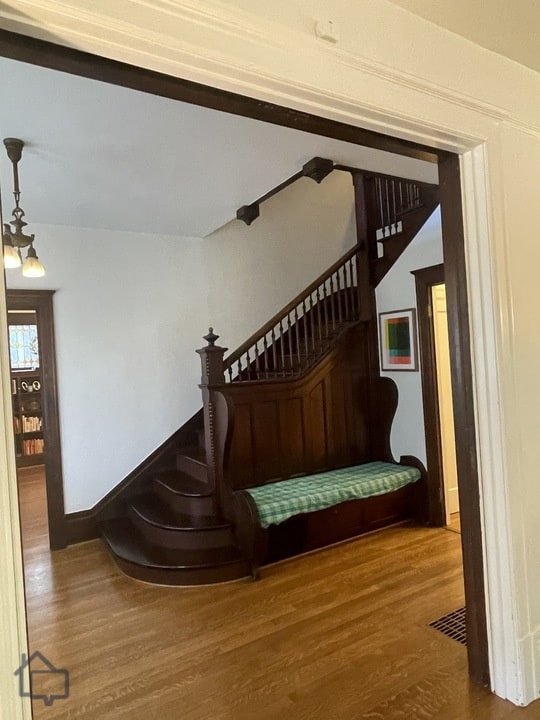
Can you spot the glass break sensor
Best and Worst Features: I was actually impressed with ADT’s selection of sensors. One of our doors has brown trim, and ADT happened to have a brown door sensor. Either that or the technician spray painted it brown out on his truck. Whatever the case, it looks legit and blends in with my door. As for size, they are smaller than Vivint’s sensors, but a bit larger than Ring, Frontpoint, and abode sensors. Any bigger and I’d say too big, but ADT made the grade here.
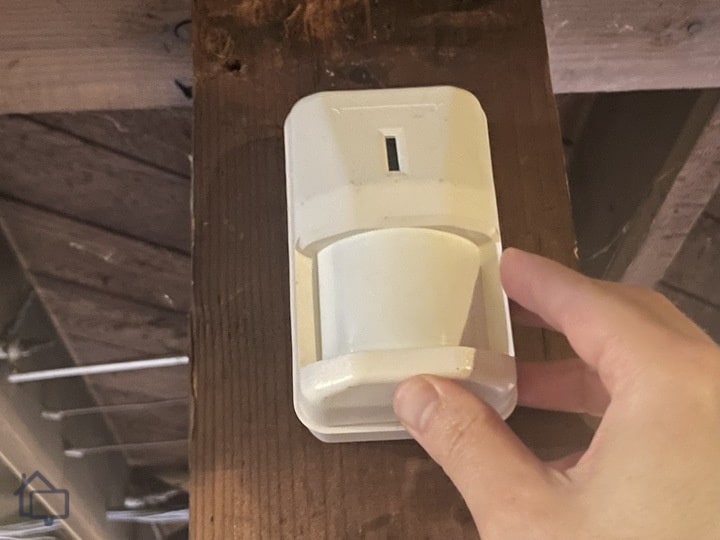
Testing Out ADT’s Motion Sensor
There’s nothing much to note about the motion sensors and glass break sensors, other than they look outdated compared to Ring’s new motion sensors. You can see them in my Ring Alarm review. I prefer Ring’s small form-factor and sleek, curvy design over ADT’s rectangular and boxy design. That said, I don’t encourage buying a security system based on the looks of its sensors; that’s just something you might want to keep in mind.
Unexpected findings: I’ve tested all kinds of home security sensors and at this point, nothing surprises me anymore. But if we’re talking about things that I found impressive in ADT’s sensors, the battery life is at the top of the list. The wireless motion sensors powered by CR123 batteries can last up to seven years.
I also found it quite unique that ADT’s motion sensor can ignore pets up to 80 lbs. The technician showed me how to adjust the sensitivity at the back of the motion sensor, in case I ever get a pet.
The best feature I found, though, was the ability of the sensors to trigger security cameras to start recording when a sensor is tripped. Automatic recordings just make it easier to review an event and see what really went down. Was it a masked burglar or just a raccoon?
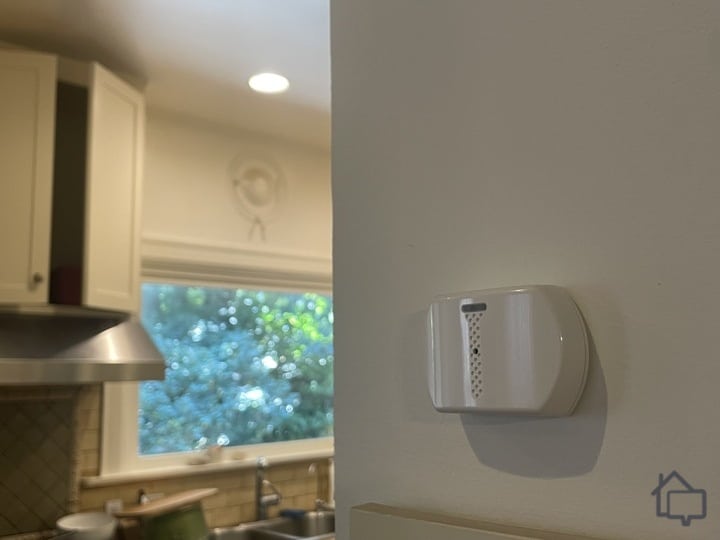
ADT’s Glass Break Sensor
Sensor Specs:
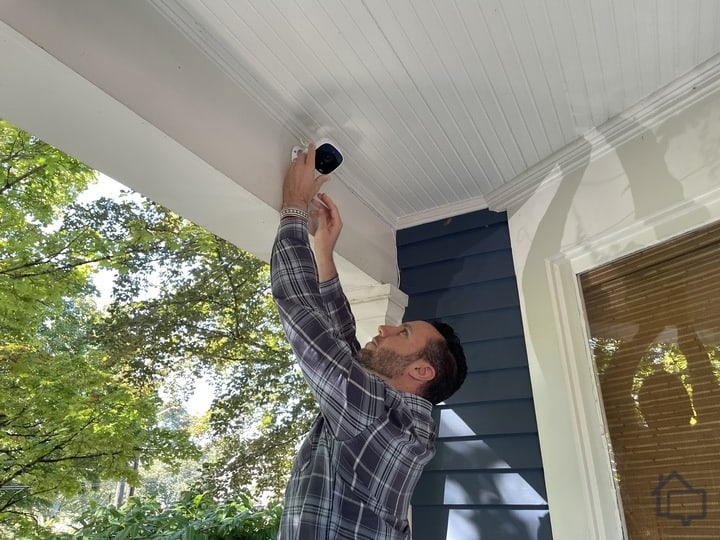
Rob Troubleshooting the ADT Outdoor Camera
What to Expect: ADT’s indoor/outdoor cameras are pretty bare-bones and honestly not worth the money. You’ll see that I had two outdoor cameras installed – one in front and one out back. Sure they’re well-made and offer the industry standard 1080p HD, but most cameras nowadays have this image quality. (If you want 4K resolution and advanced features, check out our Arlo Review and Lorex Review.) Other than a clear picture, though, these cameras didn’t do a whole lot. There’s no built-in siren, no AI facial recognition, and I found the night vision to be just passable. Not to mention I was on the phone with tech support for two hours trying to pair the cameras to the system.
Also note that ADT can get crazy with their notifications if you don’t dial-in your motion zones to reduce the sensitivity. Not exaggerating, I was getting 50-100 smartphone alerts per day for the first couple of days. Luckily, once I customized my zones so that it didn’t pick up passing cars, I wound up with far fewer alerts.
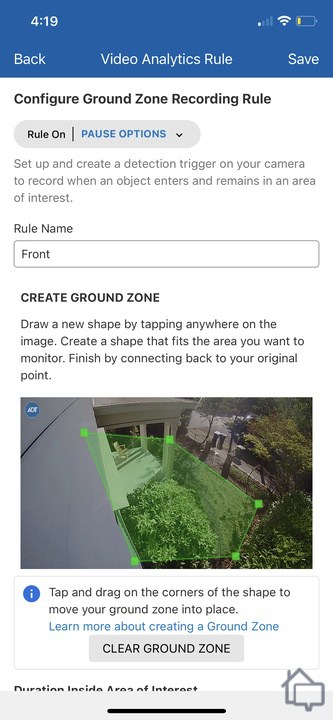
Configuring Ground Zones on our ADT Outdoor Camera
The good news is that ADT now partners with Google Nest to offer customers some of the best cameras in the industry. So below I’ll highlight the Nest Cams best/worst features and specs (because again, ADT’s cameras aren’t worth the $250). If you get cameras from ADT, do yourself a favor and get the Google Nest Cams. I recommend two outdoor cameras and one indoor camera for most medium-sized homes.
Best and Worst Features: We tested the Google Nest Cams ourselves. You can read all about these AI-powered cameras in our Google Nest Cam Review. Our favorite features were the Familiar Faces feature (AI facial recognition), custom alerts, smart home automation routines, and the clear 1080p HD resolution with HDR (high dynamic range). Essentially, it keeps lighting balanced through algorithms so you get a clear image no matter what.
I like the Nest cameras because they are cutting-edge. Want to know when your little one comes home from school? You can arrange that with the Familiar Faces feature. You can also set it to ignore movement of animals and passing vehicles – and you can do that in under two minutes. With my ADT outdoor camera, I had to tinker with the activity zones for about 10 minutes. Oh, and the Nest Cams offer activity zones too, if that’s more your style.
My biggest issue with the Nest Cam is its lack of local storage. It uses cloud storage. When your internet is out, they can’t record all motion-triggered events. Fortunately, though, I found that the battery-powered outdoor model and the plug-in indoor model can store up to 1 hour of videos locally and then upload them to the cloud when they’re back online. That’s a good short-term solution, but I would have preferred if Google Nest expanded the local storage to at least 4 hours of footage.
Nest Cam Outdoor Specs:
FYI: Google Nest offers three Nest Cam variants, all of which are available from ADT. All these models offer the same basic features, like the 1080p resolution, Familiar Face alerts, and AI person, pet, and vehicle detection. They range in price from $99 for the indoor plug-in model to $279.99 for the floodlight-equipped model. Learn more in our Nest Cam pricing guide.
As I’ve mentioned above, ADT has come out with a new security system called ADT Plus. And it changes a lot of things. It’s now the same system offered both for DIY installation (ADT Self Setup) and professional installation (the setup I tested here). But don’t worry; you didn’t waste your time reading my ADT review. ADT Plus offers a lot of the same components and features as the system I tested, from sensors to the Google Nest Cams.
Here are a few changes to note:
On top of those hardware changes, ADT has launched a new feature called Trusted Neighbor. It expands ADT’s integration with Google Nest Cams. Trusted Neighbor lets you assign people you trust to access your home at certain times or during certain events, and then automates the process to make it more seamless. Think of it like giving someone you trust a copy of your keys, except you can control when they can use their access.
It starts with facial recognition. You’ll introduce the people to whom you want to give access to Google Nest’s facial recognition. When the Nest Doorbell sees them approaching, it will send a signal to ADT and your smart lock. After just a couple of taps on their smartphone, they’d be able to enter your house with the door unlocked and the ADT system disarmed.
You’d be able to customize when each trusted person has access to your house using time- and event-based rules. You can set a schedule for your house cleaners or pet sitters, for example, or have an arrangement with a neighbor to get your pets out to safety in case your ADT system detects fire.
I’m excited to try out this feature. At the very least, it should be like granting people temporary access codes to your smart lock. But with Google Nest’s facial recognition controlling the verification and with ADT’s customizable access rules, it could take smart home security to the next level. It also fits well into our ideals on community safety; one of our suggestions is to get to know your neighbors and try to reach a level where you can trust them to help keep your home safe while you’re away.
Solid hardware that does its job is important. But, some buyers forget to consider the software side of the equation. If you can’t navigate your way through your security system’s app, there’s a good chance you’re going to make a mistake, and that could compromise your security.
Keeping in mind how important software is, ADT’s dashboard impressed me. All my videos were front and center, which meant it took less time to review footage. In minutes, I was able to see the dog that came by and sat on our front porch for twenty minutes, clock the nosy neighbor that had walked by trying to see what we were up to, and know what time the postal worker delivered the mail.
In fact, I discovered that the online dashboard offers more information and customization than the control panel. For instance, it let me create automations and schedule routines.
I will say, though, in my own tests, I found that the dashboard is better accessed from a computer or tablet than a phone.
If you’re more of a smartphone than a laptop user, ADT has you covered. I recommend the ADT Control app. It’s not much of an upgrade compared to the ADT Pulse app they had before. But don’t get me wrong; it’s a solid app for controlling your security system and then some. It’s easy to navigate, it’s user-friendly, and it provides lots of options. Think of like a control panel but with lots of extra features like home automation and security camera live streaming. I still think it’s one of the best home security mobile apps, right up there with Vivint and SimpliSafe.
FYI: ADT has a new app called ADT+, and according to the release notes when it came out in February last year, it could soon become the mobile app for professionally installed ADT systems (like the one I tested) and ADT Self Setup. As of now, only Self Setup users can use the app, but this may change in the future.
I’m a big believer that a user-friendly security system should sort of fade into the background of your life. It should fit right into your lifestyle rather than require you to change your routines just so you can stay protected. And I can say that ADT was just the right fit for me.
The ADT app is spectacular. Even when I’m home, I rarely use the control panel. The app is that simple. I use it to arm my system before heading out for my morning jog because it lets me turn on a ‘silent arming’ option. That feature isn’t available through the control panel. I also use the app to control my smart lights and thermostat, and activate smart routines. There’s something convenient about having control in your hip pocket.
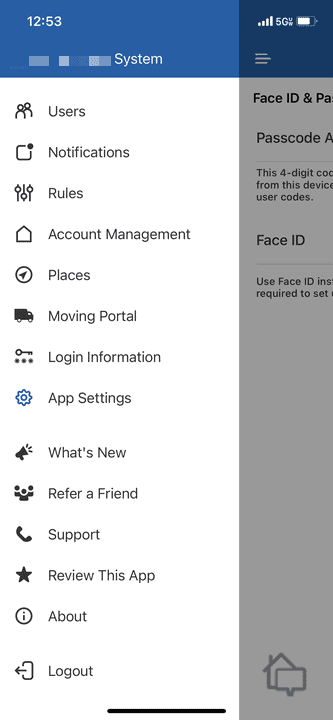
A Look at ADT’s App
I don’t hate the control panel at all, though. It’s a solid piece of equipment that offers exactly what I want from the brains of my security system: Flexibility and Reliability. Remember, it has a cellular chip, so it’s not reliant on my home Wi-Fi. For one reason or another, my internet goes out at least once a month. I can’t have a security system that offers protection only when it’s online. So that cellular chip definitely belongs in my ‘pros’ column.
Were there any downsides? Well for one, the security cameras. I’m not a big fan of their uber-sensitivity. I wasn’t exaggerating when I said I received over 50 alerts per day during the first few days. I also think ADT should have a DIY option if you’re buying additional sensors for your existing security system. As it stands, I’d have to hire a technician again to install the extra door/window sensors I’m planning to get. Those are just minor gripes though.
Besides their equipment and app, one of ADT’s best aspects is the monitoring. It’s the best in the business when it comes to professional home security monitoring, hands down. My reason for saying that? It has nine alarm response centers in the U.S. monitoring for police, fire, and medical emergencies. In comparison, most other companies have just one or two. Vivint has two in Utah and Minnesota, SimpliSafe and Frontpoint use a third-party service, and Ring has one.
What I Liked:
What I Didn’t Like:
FYI: ADT uses the same monitoring centers for its home security systems and medical alert systems. That means their agents are trained to respond to medical emergencies as well, so if you ever have one, you can use the app or control panel’s panic alarm for medical emergencies to get help. You can read our ADT Medical Alert System review if that’s something you’re interested in.
I’ve been singing praises about my ADT system, but here’s where things get dicey. If you read through ADT customer reviews online, you’ll find a ton of negative feedback. I find that that’s the case for most alarm companies. Even Frontpoint, which I hailed for having excellent customer service in my Frontpoint review, receives a lot of flak online from disappointed customers.
I think we’re just more inclined to post about a negative experience than carve out time to detail a positive interaction with a brand – unless of course you write home security reviews. I do, so here’s my experience with ADT customer service; both good and bad.
The issue: About a month after my ADT system was installed, I installed a new mesh router for better Wi-Fi reception. And of course, I wanted my ADT cameras to connect, except that they wouldn’t. I spent about 20 minutes trying to troubleshoot it on my own, but to no avail. That’s when I decided to call ADT.
My first interaction: I spoke with Patty over the phone. She was a native English speaker, very kind, and empathetic – apologetic even. I was with her on the phone for over 20 minutes, during which time we realized that it was the new mesh Wi-Fi system that was causing the issue. The cameras were set up to connect to my old Wi-Fi network. Although she couldn’t ultimately get me squared away, she found someone in the company who could.
They scheduled me for a call back with Ian from tech support. I’m not sure why the camera wouldn’t let me connect it to a new network – something I’ve been able to do with my other wireless security cameras – but the problem bothered me a lot less than the fact that Ian didn’t call me back until 1:30 pm the next day. If you’ve purchased a home security system you want it up and working as soon as possible. That was interaction one.
My second interaction: The next day, I took a late lunch so I could be home during the scheduled callback. I called ADT again, waited five minutes, and then gave them my secret passcode. I spoke with Ian and he had to remotely access my cameras to “learn them back in.” 10 minutes later, I was finally able to see my cameras from my ADT app.
Well, it was nice to have real humans to talk to. And as for Patty and Ian, I give them two thumbs up. They were professional, they explained the issue well, and they found a solution. It wasn’t the perfect customer support experience, but it was pretty solid.
Pro Tip: If you have an ADT system, don’t move your router or change your local network. If you do have to switch internet providers, keep your password and Wi-Fi name the same.
One way you can tell a system is grade A? If it has features you can’t get with other systems. ADT has that going for it.
For example, ADT’s equipment is a cut above most systems on the market. Compared to the sensors from my SimpliSafe review and Cove review – both good systems – ADT definitely has an edge. I’m financing my ADT system for three years (the length of my contract and financing plan), and I’ve no doubt it will last beyond that. ADT also stands behind its hardware with the industry-best six-month money-back guarantee.
ADT’s professional installation service also stands out. It took me only two days to have an ADT technician come to my house. I don’t remember Brinks’ buying process being that fast when I tested the Brinks security system. More importantly, I loved the “white-glove service” approach of ADT. It meant I could devote my time and attention to more important pursuits. Like Fortnite.
ADT’s biggest competition is Vivint. It’s a neck-and-neck race between the two. I’d say that Vivint is the better smart security system. It’s high-tech. For example, you can control automations and smart home devices from the control panel. It can even learn your preferences and routines to some degree. ADT lacked in that area. On the other hand, though, ADT is a much more streamlined home security system. It’s easy to use and the monitoring service is on point.
If you’re sure that you want a professionally installed and monitored security system, I recommend reading our Vivint vs. ADT comparison. That will give you an idea of how the two best security systems of that kind compare.
In any case, having a security system is a good burglar deterrent. Just the mere sight of a security company’s yard signs and window decals might convince a burglar that your home is not worth the trouble. That’s especially true if the company’s name is ‘ADT,’ one of the most recognizable brands of home security.
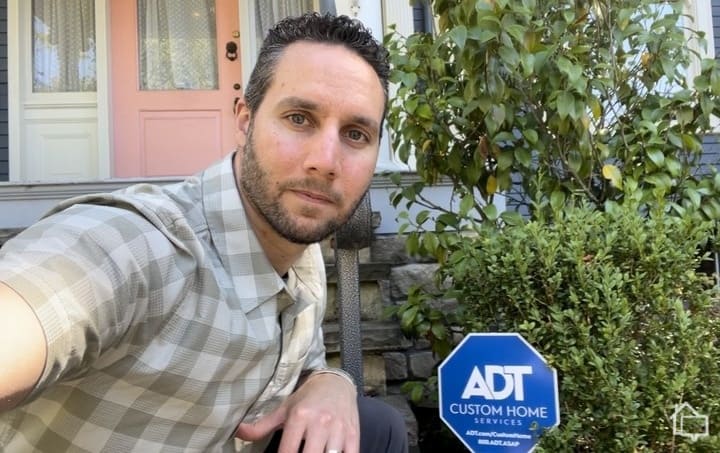
Home Security Expert Rob Gabriele Tests ADT Home Security System
Striking fear into the heart of a would-be home invader is one thing. In a concrete, practical sense, does ADT get the job done? No question. The 85 dB siren may not be loud enough to carry down the street, but if you’re breaking into a home and standing a few feet from it, it’s loud. Keep in mind, 81-percent of burglars enter through the first floor.2 That means the siren will be the first thing to confront them once they’re in.
The other asset ADT has going for it in the war with burglars is that the company now offers Google Nest cameras. If an 85 dB siren doesn’t deter burglars, you can be sure the two-way audio these cameras come with will. A loud, booming voice when you’re not expecting it should startle a potential thief away.
So now, the final verdict – Is ADT a good security system? There’s no question that it is. It offers high-quality professional installation along with sturdy equipment, it has the largest network of monitoring centers in the industry, and it has partnered with top brands like Google Nest to further improve its security system. It also offers solid complementary pieces, like the intuitive ADT app and the customizable web dashboard. Objectively speaking, ADT offers almost everything a homeowner needs to protect their home.
It’s not perfect, of course. I wouldn’t recommend it if you’re renting or living in an apartment because of the long-term contract and professional installation. It’s also not the cheapest option around. Especially if you finance your equipment, you’re looking at a monthly bill of $60 or more. If you’re looking to pay less, take a look at SimpliSafe’s prices or even Cove’s packages. Those are more affordable, but keep in mind that you’d be sacrificing some of the more premium features you can get from ADT.
Ultimately, it’s your call. ADT is a well-rounded security system, so if you think it’s the right system for you, it has our seal of approval.
Our process of reviewing and rating home security products begins with researching the different companies and security systems available. After rigorous research, we purchase the systems and bring them into our home.
We then go through the installation process – either we install the system ourselves if it’s a DIY system or observe installation for professionally installed systems. Once installed, we put the system through dozens of simulated burglaries, home invasions, and package theft situations to see how well it can protect our home.
A typical home security test will take us several days to several weeks, and it’s not uncommon that we’ll test and tinker with products for several months. Our aim is to fully understand what it’s like living with the system so that we can give an honest and unbiased recommendation. That’s our promise to our readers like you.
As a professionally installed system that also requires professional monitoring, ADT is more expensive than DIY security systems like SimpliSafe, abode, Cove, and Ring Alarm. However, compared to similar systems like Vivint and Brinks, ADT’s pricing is competitive, especially with financing plans for equipment.
The cost of an ADT system depends on size and components of the system. A basic equipment package can cost as little as $370, but a comprehensive system can cost more than $1,000. To offset this cost, ADT offers flexible financing plans. You can pay for your equipment over the course of 24 to 60 months, with fees ranging from less than $10 to $30+ per month. After that, you’ll pay a monthly monitoring fee, which is somewhere in the $25 to $40 range.
No, ADT systems have dual-path communication technology. The control panel communicates with the monitoring center and the ADT app via Wi-Fi, but in case it goes offline, it can use the built-in cellular chip to maintain constant communication.
An ADT control panel can handle up to 40 cameras. That’s more than enough for most homes. We typically recommend having two to three cameras outdoors and two security cameras for indoor protection.
ADT security systems are leased, not owned, so if you cancel your monitoring service, ADT will pull out your security system. If you’re still under contract, you may also be liable for an early termination fee.
FBI. (2017). Crime Clock.
https://ucr.fbi.gov/crime-in-the-u.s/2017/crime-in-the-u.s.-2017/topic-pages/crime-clock
International Association of Certified Home Inspectors. (2024). Burglar-Resistant Homes.
https://www.nachi.org/burglar-resistant.htm